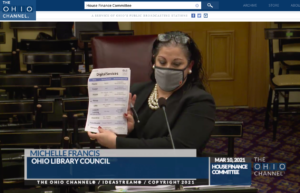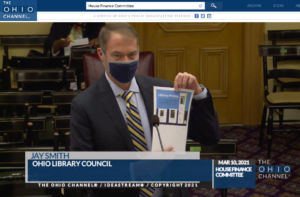OLC Testifies on State Budget Bill Before House Finance Committee
Today, the OLC testified on House Bill (HB) 110, the biennial state budget bill, in front of the Ohio House Finance Committee. OLC’s Executive Director Michelle Francis told lawmakers how public libraries were able to quickly pivot and adjust their service delivery models to continue to meet the needs of their local communities during the pandemic. Francis provided specific examples of what libraries did when the pandemic started and what they continue to do today, such as:
- curbside, drive-through and delivery service
- virtual storytimes
- tech training
- assistance for homeschoolers and remote learners
- job search assistance
- and loaning Wi-Fi hot spots

OLC’s Executive Director Michelle Francis explains how Ohio’s public libraries increased digital services and expanded internet access during the pandemic.
Francis explained that Ohio’s public libraries recognized the need for broadband connectivity long before the pandemic and the majority of libraries are now loaning mobile Wi-Fi hotspots. She showed the committee an example of a hotspot from the Upper Arlington Public Library. Francis described how libraries across the state are loaning these devices in order for people to access the internet, especially since so much has shifted online.
“As we come out of the pandemic, Ohio’s public libraries will be here to work with our schools to address the pandemic educational gaps we are seeing in Pre-K and Kindergarten as well as minority populations and economically disadvantaged communities,” Francis said. “We will be here to assist in workforce development efforts to help displaced workers take online courses and apply for employment. We will still be here providing programming and lifelong learning opportunities for all ages. However, to continue these efforts, we will need resources.”
In Governor DeWine’s state budget proposal released in February, he highlighted the work and importance of Ohio’s public libraries. However, the Executive Budget cuts state funding to Ohio’s public libraries by reducing the Public Library Fund (PLF) from 1.7% to 1.66% of the General Revenue Fund (GRF).
Jay Smith, OLC’s Director of Government and Legal Services explained that the PLF is not a line-item appropriation like other programs and state agencies in HB 110. It is in permanent law and is a set percentage of the state’s monthly tax receipts that go into the GRF. He described how the PLF ebbs and flows each month depending on state revenues and that it is currently set in temporary law at 1.7% of the GRF for FY 2021.
“We would like to formally thank the General Assembly for your work over the last three budget cycles to begin to restore state funding to Ohio’s public libraries through the Public Library Fund,” Smith said. “Unfortunately, it is those efforts that are now in jeopardy under the Governor’s proposal for FY22-23.”

Jay Smith, OLC’s Director of Government and Legal Services shows the committee library pricing for eBooks and the impact those costs have on library budgets.
Smith urged members of the Ohio House to keep the PLF at the current (FY21) rate of 1.7% because there are still several unknowns regarding Ohio’s economy and the budget process between now and June 30 that could impact the state’s GRF base and ultimately reduce the PLF. He also explained that libraries are facing increasing costs right now.
“In 2020, public libraries saw a 33% increase in digital book circulation (eBooks and audiobooks) over 2019,” Smith said. “This significantly impacts budgets because of the increased costs associated with eBooks.”
Smith described how a James Patterson book would cost the average consumer $14.99 for the eBook on Amazon. In comparison, the library pays nearly five times as much —$65 for the same eBook. He added that the publishers also charge libraries to renew the license in 24 months.
“State funding through the PLF is critically important because it remains a primary source of revenue for public libraries. Statewide, more than 48% of the total funding for Ohio’s public libraries comes from the state through the PLF,” Smith said. “In addition, 20% of Ohio’s public library systems do not have a local property tax levy and rely solely on their state funding as their main source of revenue for day-to-day operations.”
Smith explained that state funding for Ohio’s 251 public library systems will be reduced unless the budget is amended to keep PLF funding at current levels. He also added that only once in the past seven years the PLF actually met projections.
“Investing in public libraries is critical as the usage and demand for our services is growing and broadening – especially as we assist in Ohio’s recovery efforts, ” Smith said. “None of the services Michelle mentioned earlier would be possible without our state funding. Making public libraries a priority in this budget and maintaining the PLF at 1.7% is a step in the right direction.”
The testimony was covered live on the Ohio Channel and a recording is available on the Ohio Channel website. [OLC testimony begins at 25:17 mark].
A transcript of the testimony is also available on the OLC website.
More information is available at libraryfunding.olc.org.


